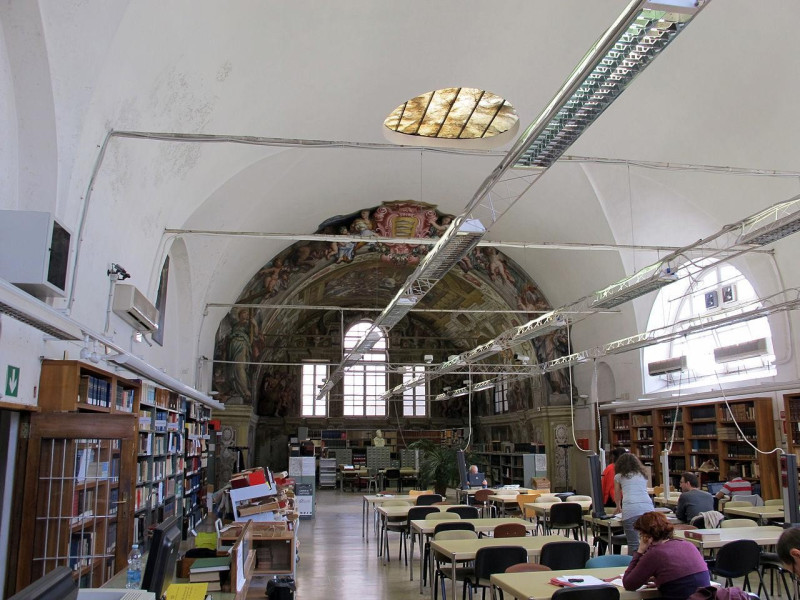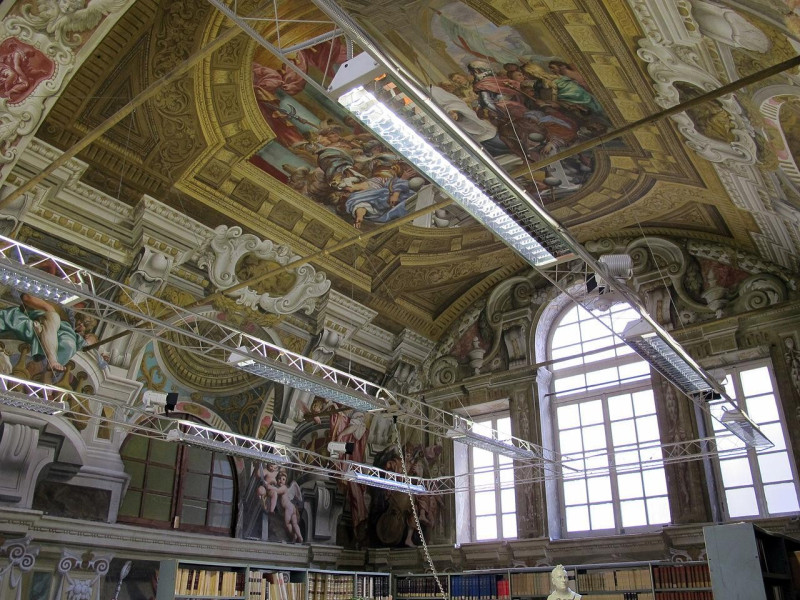Biblioteca Universitaria di Genova
Major bibliographic Institute of Liguria, the owner of the mandatory deposit of printed of the province of Genoa, the Library has about 600.000 units of books, pamphlets, manuscripts, incunabula, autographs, magazines. The halls of the library are 34. The first three halls collect most of the wealth of books printed from the College and the Professed House of the Jesuits in Genoa and suppressed religious congregations in '700 and '800. Apart from the "Third Room", which takes the place of the original Jesuit Library, the "First Room", the vestibule and the rooms 33 and 34, which are located in a warehouse outside the Library, the other rooms are all included in the inventory book occupying the central nave of the church and a chapel on the right. In the chapel on the left was built, in 1935, the "Hall of Rare Manuscripts" that even today, with the ''Atrium of Rares", contains the most valuable material of the institute. The other rooms, until the ninth understood, are heterogeneous nature. The Rooms from the eleventh to the thirty-second, created after World War II, correspond to one or more related subjects. The rooms 33 and 34, newly established, mainly collect the works of the XVI - XVIII only partially cataloged. Also in the store there are the rooms of books called "Ligure" and "Corsica": the first one started in 1865 by Emanuele Celesia, librarian who collects printed texts or authors in Liguria, includes about 6.000 volumes; the second one, is made up of some 180 books and pamphlets relating to Corsica.
The library also owns a number of bibliographical received the '20s -' 30s: the Biblioteca Manuel Belgrano (donation from Argentina, comprises 1.500 volumes relating to the history of the Argentine territory), the Geographical of American States (available to the government in 1931, includes approximately 1.200 volumes); the Library of the Military Presidio (permanent disposal of 1934, consists of texts on the subjects of war); Laura's Fund (consisting of 13.000 books and pamphlets that are largely philosophical and religious, sociological and literary arguments); Rossello's Fund (legacy of the '30s, includes approximately 1.500 volumes, especially in the fields of law); Gropallo's Fund (about 1.750 volumes largely of literary texts).
During the first half of '900 there have been many donations and bequests both of library materials in both print of manuscript material. Among these, there are the precious gift from Gerolamo Gaslini, 1942 (60 manuscripts and 120 incunabula of humanistic period), the Umberto Fracchia's Fund, arrived in 1982 (including works of literary manuscripts and printed) and the Luigi Pelloux, in the same year (contains argument works mainly historical and military).
Even the purchasing policy has increased the collections over the years: in 1954 it is acquired from the Ministry of Education a collection belonging to the family De Gaudenzi (contains mostly editions and criticism of D'Annunzio) and the recent purchase of the Rodocanachi's Fund is of great interest for the literary history of the '900.
In the Conservation Sector of the library, which houses memorabilia and rares around the bottom of the manuscripts, as well as valuable codes and choral liturgical, are particularly interesting large collection of autographs (about 14.000, partially merged with the various directors of the library that had contact with many people from intellectual and political world) and the Nino Bixio's Fund, known as "Autographs of the Renaissance" (includes fourteen boxes of correspondence and notes).
For a long time the current home, even if expanded to the halls of Via Balbi 38b, failed to provide sufficient space to house the library collections. To remedy this problem, the Ministry of Heritage and Culture has acquired the seat facing the train station Piazza Principe, the former Hotel Colombia. This new and prestigious house will allow the library to expand services and coagulate projects and cultural forces in a seat completely renovated.


